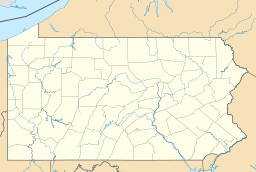Beaver Run Reservoir facts for kids
Quick facts for kids Beaver Run Reservoir |
|
|---|---|
| Beaver Dam Reservoir | |
| Location | Westmoreland County, Pennsylvania |
| Coordinates | 40°28′55″N 79°33′25″W / 40.482°N 79.557°W |
| Type | reservoir |
| Surface elevation | 1,053 feet (321 m) |
Beaver Run Reservoir, also known as Beaver Dam Reservoir, is a large man-made lake. It is located in Westmoreland County, Pennsylvania, about 23 miles (37 km) east of Pittsburgh. The reservoir sits 1053 feet (321 meters) above sea level.
This important reservoir provides drinking water for about 150,000 people. Many towns get their water from here, including Murrysville, Export, and Delmont.
To keep the water clean and safe for everyone, certain activities are not allowed. For example, you cannot go fishing in the reservoir. Hiking near the reservoir is also not permitted. These rules help protect public health.
Contents
Gas Drilling Near the Reservoir
The area around Beaver Run Reservoir has natural gas underneath it. The local water company, called the Municipal Authority of Westmoreland County (MAWC), leased this land. They allowed companies to drill for gas starting in 1999. Since then, about 100 shallow gas wells have been drilled.
Deep Drilling and Fracking
In 2008, companies started drilling much deeper for gas. This deeper gas is found in a rock layer called the Marcellus shale. To get this gas out, they use a method called fracking. Fracking involves pumping water, sand, and chemicals into the ground at high pressure. This creates small cracks in the rock, allowing the gas to flow out.
As of 2013, 41 deep wells have been drilled on six different drilling sites. The company doing this drilling is CNX Gas, which is part of Consol Energy.
Chemicals Used in Fracking
Fracking uses various chemicals mixed with water. The MAWC has shared some information online about the chemicals Consol uses. While details like exact locations or amounts are not always public, safety sheets explain what these chemicals are.
Some of the chemicals that have been mentioned include:
- hydrochloric acid
- DAP-901-1, which contains methanol and phosphoric acid
- DWP-938-1, which contains methyl alcohol
- DWP-944-3, which contains polyethylene glycol
- crystalline silica
Spill Incident
In June 2013, there was a small spill near the reservoir. About 100 gallons of recycled wastewater from fracking leaked into the ground. This wastewater can contain chemicals and salts.
To clean up the spill, workers dug up the affected soil. They also tested the ground for chloride levels, which can show if there's pollution. The tests showed that the chloride levels were acceptable. Fracking activities then started again a few days later.


